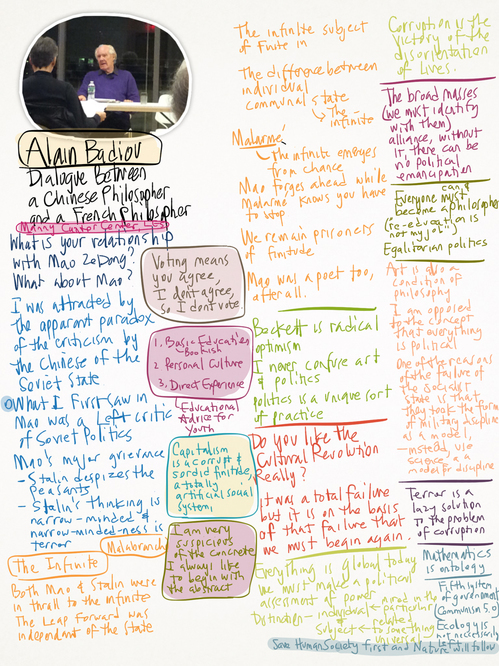December 28, 2014
December 18, 2014
...Worlds & ...Mysteries
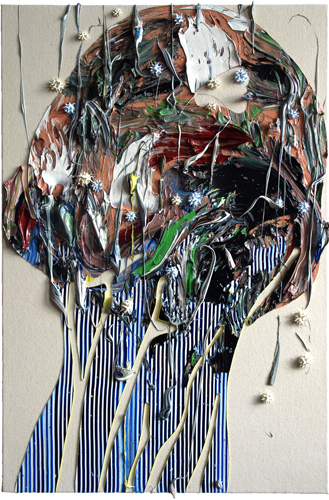
...Worlds & ...Mysteries
2014
#481
30"x20"
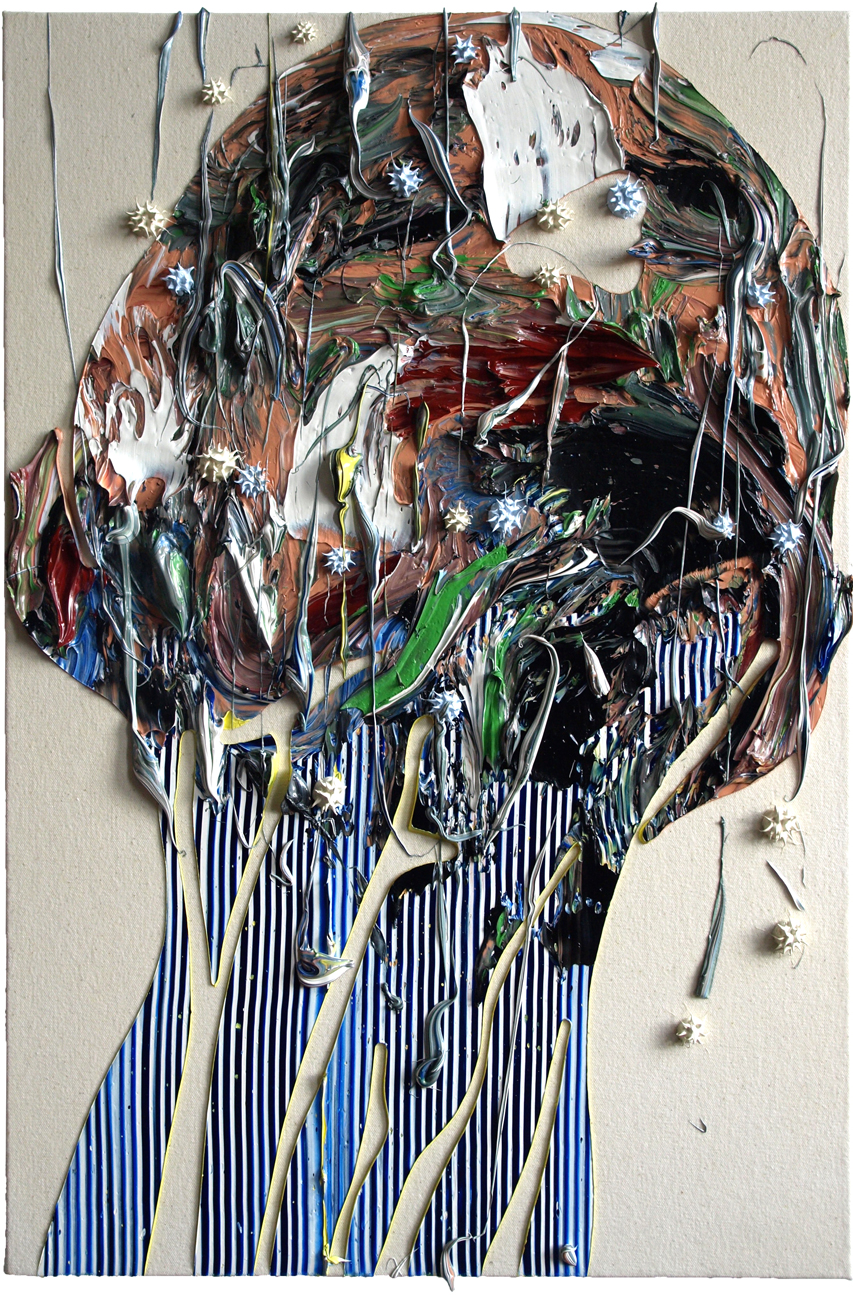
Badiou in NYC
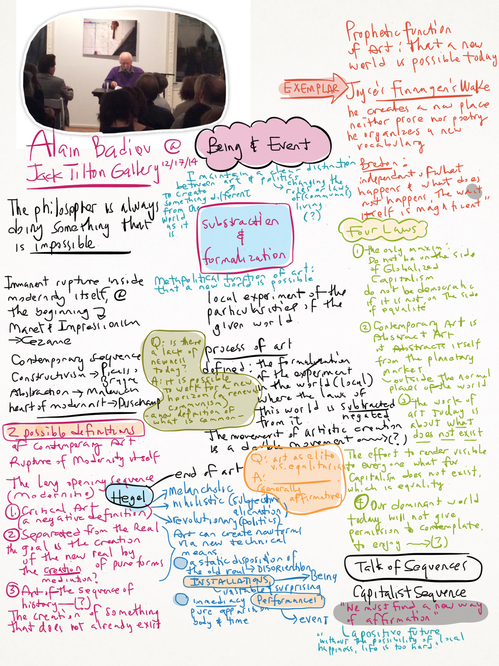
It was a treat to be able to catch a couple of lectures by Alain Badiou during his tour of NYC this week. Here are notes that I took from them, one given at the Manny Cantor Center where he dramatized "... Chinese Philosopher" and another "Some Fundamental Characteristics of Art" at Jack Tilton's Gallery in the Upper East Side. I won't claim to know his work, I only have a passing familiarity from various YouTube videos of his lectures that I've seen over the years, so it was a delight to hear him deliver his ideas in person.
I am in the midst of understanding Badiou's ideas, and whatever I write here is provisional since my grasp is less than tentative. His focus on truth and infinity runs against the past fifty or sixty years of postmodern relativism, so I perk up and try to piece the ideas together. The idea of rupture and modernity sends me back to my own formulation/perspective of art history (a rude summary: the narrative of freedom valorized the individual in the West, this flowered in the Renaissance and ossified into Classicism which provoked a rupture -aided by successive Industrial Revolutions- into modernity. The modern and postmodern were born together, the former effloresced early while the latter gestated to be birthed in the ashes of the New York School of AbEx. The torrent of postmodernism ran like a watercourse from the icy streams of Pop, Minimalism and Conceptualism to broad slow rivers of Critical Theory towards the inevitable spreading delta marshes we are living in today: oozing, stinking and evaporating into the sky. It is my hope that the clouds we are forming will cluster in the mountaintops to form the dew that will become the river of the coming epoch) ...and I'm starting to trace how Badiou correlates his idea of rupture in art to politics. It's curious to me that Badiou has elided postmodernism and I note that his ideas about affirmation has become popular to young artists today, a generation who seem -at least to me- to be looking for a way forward, an alternative to the legacy of postmodern negation.
As for Badiou's politics, I puzzle about his commitment to Communism, and I note that he has a huge audience here in NYC who seem sympathetic to its utopian promise. I remain critical of Communism, but I listen earnestly to those who offer apologetics for it (my own politics are hybrid, center/center). I don't think art exists in a Communist eschaton, save the pale avatar -mere illustration- that reinforces the ideology that polices the existence of the promised classless, stateless unicorn paradise. If what my Leftist friends are longing for is a better and just world -and I long for it too- then I would reply that kindness does not require theory. We don't need elaborate theoretical constructions to be good to one another.
Note 1: Googling for Badiou on art, I found Jörg Heise's great summary of late 20th century influence of philosophy on art (or visa versa) in his article in a 2009 Frieze Do philosophers understand contemporary art? Along the way, I found a profound premonition for what we are today calling Zombie Abstraction:
In 1987, Baudrillard gave a couple of lectures in New York. Asked what he thought of artists such as Peter Halley and Sherrie Levine, he flatly rejected their work as a complete misunderstanding of his writing 'because the simulacrum cannot be represented.' Baudrillard was right, you can't represent the simulacrum - to do so is a contradiction in terms. But, only able to see the old in the new, he was wrong to reduce this kind of work to rehashed Warhol (who, for Baudrillard, had already finished the job of turning banality into fetish). It wasn't until 1996 that he issued his pamphlet 'The Conspiracy of Art' in which he asserted that the only gesture left to contemporary art, now that it had immersed itself completely into all areas of life and had lost the right to claim exceptional status, 'was the wink of reality laughing at itself in its most hyperrealist form'. In control of art are 'the inside traders, the counterfeiters of nullity, the snobs of nullity'. It was as if he was still railing against his mid-1980s encounters in New York, echoing the legions of rejected artists, critics, and art lovers who had long bemoaned the conspiracy of art world charlatanry.(emphasis mine)
Note 2: This is the text (which I found online after the fact) that Badiou read at Tilton.
Note 3: A list of Badiou's aphorisms can be found here.
Note 4: As for Badiou's desire for a second cultural revolution "It was a total failure, but it is on the basis of that failure that we must begin again", it would be wise to remember the depths of that failurewhat happened in the first one:
The Revolution was launched in May 1966. Mao alleged that bourgeois elements had infiltrated the government and society at large, aiming to restore capitalism. He insisted that these "revisionists" be removed through violent class struggle. China's youth responded to Mao's appeal by forming Red Guard groups around the country. The movement spread into the military, urban workers, and the Communist Party leadership itself. It resulted in widespread factional struggles in all walks of life. In the top leadership, it led to a mass purge of senior officials, most notably Liu Shaoqi and Deng Xiaoping. During the same period Mao's personality cult grew to immense proportions. Millions of people were persecuted in the violent struggles that ensued across the country, and suffered a wide range of abuses including public humiliation, arbitrary imprisonment, torture, sustained harassment, and seizure of property. A large segment of the population was forcibly displaced, most notably the transfer of urban youth to rural regions during the Down to the Countryside Movement. Historical relics and artifacts were destroyed. Cultural and religious sites were ransacked.
Here's what happened in the precursor, the Great Leap Forward:
December 17, 2014
What if we are instead, algebraic?
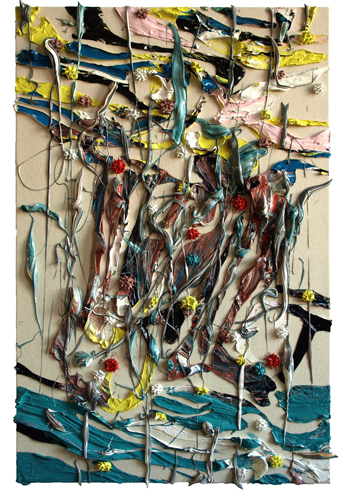
What if we are instead, algebraic?
2014
#480
30"x20"

